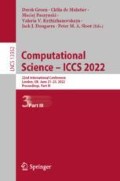Abstract
Heart attack (HA) is a sudden health disorder when the flow of blood to the heart is blocked, causing damage to the heart. According to the World Health Organization (WHO), heart attack is one of the greatest causes of death and disability globally. Early recognition of the various warning signs of a HA can help reduce the severity. Different machine learning (ML) models have been developed to predict the heart attack. However, patients with arterial hypertension (AH) are especially prone to this disorder and have several features that distinguish them from other groups of patients. We apply these features to develop a special model for people suffering from AH. Moreover, we contribute to this field bringing more transparency to the modelling using interpretable machine learning. We also compare the patterns learned by methods with prior information used in heart attack scales and evaluate their efficiency.
Access this chapter
Tax calculation will be finalised at checkout
Purchases are for personal use only
References
Kirubha, V., Priya, S.M.: Survey on data mining algorithms in disease prediction. Int. J. Comput. Trends Technol. 38(3), 124–128 (2016)
Hastie, T.J., Tibshirani, R.J.: Generalized Additive Models. Routledge, New York (2017)
Agarwal, R., et al.: Neural additive models: interpretable machine learning with neural nets. In: Advances in Neural Information Processing Systems 34 (2021)
Khedkar, S., Subramanian, V., Shinde, G., Gandhi, P.: Explainable AI in healthcare. In: Healthcare 2nd International Conference on Advances in Science & Technology (ICAST) (2019)
Lakkaraju, H., Bach, S.H., Leskovec, J.: Interpretable decision sets: a joint framework for description and pre-diction. In: Proceedings of the ACM SIGKDD International Conference on Knowledge Discovery and Data Mining, pp. 1675–1684, 13–17 (2016)
Khedkar, S., Subramanian, V., Shinde, G., Gandhi, P.: Explainable AI in healthcare. In: Healthcare (April 8, 2019). 2nd International Conference on Advances in Science & Technology (ICAST) (2019)
Soni, J., Ansari, U., Sharma, D., Soni, S.: Intelligent and effective heart disease prediction system using weighted associative classifiers. Int. J. Comput. Sci. Eng. 3, 2385–2392 (2011)
Florence, S., Bhuvaneswari Amma, N.G., Annapoorani, G., Malathi, K.: Predicting the risk of heart attacks using neural network and decision tree. Int. J. Innov. Res. Comput. Commun. Eng. 2, 7025–7030 (2014)
Jabbar, M.A., Deekshatulu, B.L., Chandra, P.: Graph based approach for heart disease prediction. In: Das, V. (eds.) Proceedings of ITC 2012. LNEE, vol. 150, pp. 465–474. Springer, New York (2012). https://doi.org/10.1007/978-1-4614-3363-7_54
Westerlund, A.M., Hawe, J.S., Heinig, M., Schunkert, H.: Risk prediction of cardiovascular events by exploration of molecular data with explainable artificial intelligence. Int. J. Mol. Sci. 22(19), 10291 (2021)
Dağlarli, E.: Explainable artificial intelligence (xAI) approaches and deep meta-learning models. In: Advances and Applications in Deep Learning, vol. 79 (2020)
Duell, J., Fan, X., Burnett, B., Aarts, G., Zhou, S.M.: A comparison of explanations given by explainable artificial intelligence methods on analysing electronic health records. In: IEEE EMBS International Conference on Biomedical and Health Informatics (BHI), pp. 1–4. IEEE. (2021)
Aghamohammadi, M., Madan, M., Hong, J., Watson, I.: Predicting heart attack through explainable artificial intelligence. In: Rodrigues, J.M.F., et al. (eds.) ICCS 2019. LNCS, vol. 11537, pp. 633–645. Springer, Cham (2019). https://doi.org/10.1007/978-3-030-22741-8_45
Systematic COronary Risk Evaluation (SCORE). https://www.escardio.org/Education/Practice-Tools/CVD-prevention-toolbox/SCORE-Risk-Charts
Acknowledgement
This work was supported by the Ministry of Science and Higher Education of Russian Federation, goszadanie no. 2019-1339.
Author information
Authors and Affiliations
Corresponding author
Editor information
Editors and Affiliations
Rights and permissions
Copyright information
© 2022 The Author(s), under exclusive license to Springer Nature Switzerland AG
About this paper
Cite this paper
Balabaeva, K., Kovalchuk, S. (2022). Neural Additive Models for Explainable Heart Attack Prediction. In: Groen, D., de Mulatier, C., Paszynski, M., Krzhizhanovskaya, V.V., Dongarra, J.J., Sloot, P.M.A. (eds) Computational Science – ICCS 2022. ICCS 2022. Lecture Notes in Computer Science, vol 13352. Springer, Cham. https://doi.org/10.1007/978-3-031-08757-8_11
Download citation
DOI: https://doi.org/10.1007/978-3-031-08757-8_11
Published:
Publisher Name: Springer, Cham
Print ISBN: 978-3-031-08756-1
Online ISBN: 978-3-031-08757-8
eBook Packages: Computer ScienceComputer Science (R0)

